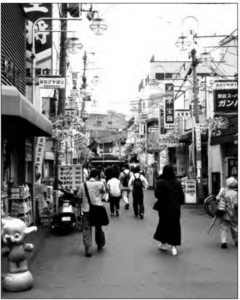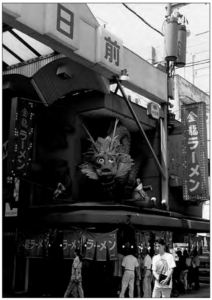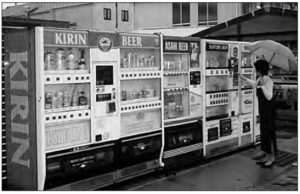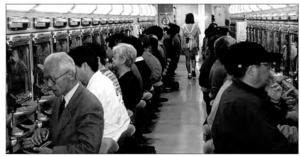Japan’s meteoric rise from the ashes of World War II has been described by many as an economic miracle. Between 1960 and 1985, real income per person in Japan grew three times as fast as in the U.S. Remarkably, with few natural resources of its own, the Japanese economy became second in size only to the United States without creating serious inequality of income and wealth among its citizens. Indeed, of all industrialized countries, Japan has the most equal distribution of income.

Photo by Frank Mak
Many of us grew up with newspaper and magazine stories about the technological wonders of Japan in the 1970s and the managerial and economic wonders of the Japanese corporations in the 198 0s. It was a surprise to learn that a part of Japan’s postwar economic miracle might have been a bubble that burst in the 1990s. While the sharp drop in land and stock prices 1 has been singled out as the chief source of the ensuing recession, the slow and sputtering economic recovery and declining productivity growth suggest that the collapse of the real estate and stock markets may have been mere symptoms, not causes, of the problem. Many experts now believe that the Japanese economy needs structural overhaul before it can be expected to resume sustained, long-term economic growth.2
In his superb book, Frederick L. Schodt sketches the development of four American views of Japan: friend, foe, model, and mirror.3 In the 1970s and 1980s, Japan served as a model for other aspiring countries in Asia. However, in the nineties, a fifth view of Japan as a “lesson” is emerging. The “lesson,” as the Japanese are painfully discovering, is that economic institutions and policies that worked so well to enable the country to catch up to the Western industrialized countries might not work very well when the country has caught up to, and in many cases leap-frogged past, its competitors.
THE JAPANESE POSTWAR ECONOMIC MODEL
Professor Takatoshi Ito of Hitotsubashi University recently identified several key policies and institutional features of the Japanese economy which he believes contributed to Japan’s rapid economic growth in the post-World War II period.4
INDUSTRIAL POLICY—During the 1950s and 1960s, the Japanese government picked certain “sunrise” industries thought to be potential winners in the global economic race and helped them through low-interest loans and allocation of scarce foreign exchange so they could import what they needed. Pushing exports lay at the heart of this so-called “industrial policy” to promote economic development. The government protected the producers in these favored industries by restricting domestic competition and by raising tariff and quota barriers to keep imports out. Given breathing room to learn and become efficient, these favored infant industries were supposed to grow into world-class competitors and then be weaned from government protection. Import restrictions would then be reduced and Japanese domestic markets opened to foreign goods.
Whether this policy of nurturing selected industries to become winners achieved the goal of accelerating Japanese economic growth is still being researched and debated. We do know that during this high-growth period the composition of Japanese exports changed rapidly from low-quality, cheap goods such as textiles and toys in the 1950s to world-class quality automobiles and semiconductors in the 1980s. Japan sold far more goods abroad than it imported and accumulated persistent and large annual trade surpluses.
HIGH HOUSEHOLD SAVINGS RATE — A high rate of household savings financed Japan’s economic growth. Between 1960 and 1994, Japanese households saved about one-sixth of their after-tax incomes, more than twice that of American households. One popular theory attributes Japan’s high household savings rate to culture, tradition, or national character. However, the fact that Japan’s household savings rate was not always high (it was negative before World War II) suggests that culture is not the principal explanation.
The country’s high rates of economic growth in the postwar period, government programs and tax breaks to promote savings, lack of consumer credit to buy big-ticket items such as homes, household furniture and appliances, and low level of social security benefits until the early 1970s are some of the reasons why Japanese have saved so much more of their incomes than Americans. Japan’s high savings rate has been a major contributor to its high rate of investment to create productive capacity. It also financed direct and indirect investment abroad, including in the U.S.
EDUCATION AND LITERACY— Japan has one of the highest literacy rates in the world. The Ministry of Education tightly oversees an egalitarian primary and lower secondary public education system by exercising its broad authority over school curriculum, teaching manuals, and textbooks. Admission to coveted schools, from primary through college levels, is determined by competitive entrance examinations. Although students in Japan are only required to go to school through the ninth grade (i.e., junior high school), 95 percent of them now continue on to high school (compared to only 58 percent in 1960). This is among the highest rate of high school attendance in the world.

Photo by James Mak
Until recently, Japanese children went to school six days per week; Saturday morning classes have been cut back to twice monthly. Compared to students in the U.S., Japanese (and other Asian) students score high in literacy, standardized mathematics, and science tests. About 44 percent of male and 48 percent of female Japanese high school graduates go on to higher education.5 Female students are more likely to go to junior college, while male students overwhelmingly choose to go to four-year universities. Japan’s educated and industrious labor force is an important reason for its postwar economic success.
EMPLOYMENT SECURITY—New graduates leave Japanese schools and universities in March of each year and officially begin their employment in April. Among college graduates, the best and the fortunate, usually from the most prestigious schools, are hired by large, well-established companies or enter civil service and can expect (though not contractually guaranteed) lifetime employment. Lifetime employment essentially means that a new employee is expected to work for the same company until he retires. Smaller companies do not offer the assurance of long-term employment.
The Japanese compensation system is designed to encourage workers to stay with the company. Typically a regular employee’s starting pay is relatively low, but rises rapidly with age and seniority. If the employee quits the company, he may have difficulty finding a comparable job, and even if he does, his pay is likely to be substantially lower than what he left behind. There would also be a huge reduction in his future lump sum retirement payment if he changes employers.

Photo by Frank Mak
© University of Hawaii Press, Reprinted with permission
Thus, the steep age-wage profile in Japan encourages the worker to work hard, improve his skills, demonstrate unquestioned loyalty, and stay with his company. The employer is also more willing to invest in training employees who are expected to stay with the company. As a result, the high level of employment security contributes to the growth of Japanese firms, which in turn enables companies to provide secure employment to their employees.
The Japanese today enjoy a high level and equality of income, little poverty, universal access to health care, and the highest life expectancy in the world.
KEIRETSU AND THE MAIN BANK SYSTEM— Many businesses in Japan are affiliated with groups called keiretsu. Members of horizontal keiretsu represent diverse businesses, tend to borrow mainly from a primary lender, the main bank, hold one another’s shares, and sometimes exchange personnel. The president, chief executives, and directors of the core corporations meet monthly. Well known companies such as Mitsubishi Bank, Mitsubishi Corporation, Mitsubishi Heavy Industries, and Mitsubishi Motors are all affiliated companies that belong to one of six major horizontal keiretsu in Japan. In the vertical keiretsu, member firms are linked through the supply and distribution chains of a major manufacturer—its core firm. Toyota, the well-known automobile manufacturer, is an example of this type of keiretsu. Japanese automobile manufacturers, like Toyota, produce only about 20 percent of the parts they use in-house and buy the rest from parts manufacturers; by contrast, American and European automobile manufacturers produce about 50 percent of the parts they use.6 Toyota itself belongs to a major horizontal keiretsu with Mitsui as its main bank.7
Horizontal keiretsu permit the main bank to gain access to detailed insider information, use it to monitor the member firms, and to influence their policies. Outsiders also may rely on monitoring by the main bank, and invest in these companies without incurring investigative costs of their own. Membership within a (vertical) keiretsu facilitates technology transfers among member firms. Keiretsu members may also assist other members in financial distress by providing preferential loans, prices, and buying their products. For example, Sumitomo Bank extended substantial credit and sent some key bank personnel to advise the troubled Mazda automobile company. Mutual shareholdings protect member firms from hostile takeovers, so they can focus on longterm strategies instead of short-term profitability. This longer term focus has frequently been cited as a competitive advantage of Japanese corporations.
UNBALANCED PROGRESS
The Japanese today enjoy a high level and equality of income, little poverty, universal access to health care, and the highest life expectancy in the world. Compared to Americans, the Japanese also have lower crime, unemployment, and divorce rates, lower infant mortality, fewer teenage pregnancies, and lower drug addiction.
However, in many aspects of their daily lives, the Japanese do not live as well as Americans. Japanese workers take fewer days of vacation each year and spend more time commuting to and from work. Until a few years ago, Japanese manufacturing production employees worked more hours per year than Americans. However, a sharp drop in hours worked in Japan and a smaller rise in the U.S. since the early nineties has reversed this relationship.8
Except for its excellent system of public transportation, Japan lags behind the U.S. in roads, ports, airports, sewage treatment, parks, and other social infrastructure. Japanese consumers face higher domestic prices than those in the rest of the world. Japan’s Economic Planning Agency (EPA) estimates that in 1996 prices of goods and services in Tokyo were 33 percent higher than in New York, 28 percent higher than in London, 19 percent higher than in Paris, 24 percent higher than in Berlin, but 8 percent lower than in Geneva. Housing is cramped and expensive. Food, even rice—the staple of Japanese diet—is more expensive than in the U.S.9
Although Japan is one of the leading industrial countries in the world, Japanese economic policies continue to favor businesses at the expense of consumers. For example, in the financial sector banks were expected to support industry by lending to and investing in Japanese corporations; they were not encouraged to provide consumer loans or other consumer services.
The Bank of Japan gave low interest money to banks to lend to businesses, and used its “window guidance” as a form of moral suasion to get the banks to comply with government policy. Even as capital controls were relaxed, bank services for consumers remain poor. Commercial banks offer checking accounts to businesses but not to individuals (except a few very wealthy individuals). Until very recently, bank ATM machines closed around 7 p.m. and are only open for limited hours on Saturdays.10 Compared to American banks, Japanese banks have shorter business hours (9:00 a.m. to 3:00 p.m., Monday-Friday) and are not open on weekends.

© University of Hawaii Press
Japan’s postwar industrial policy requires close coordination between government and businesses. This coordination function is relegated to powerful bureaucrats who staff government ministries. Retired high-level government bureaucrats typically end up working for the same corporations that they were previously assigned to monitor. This cozy relationship provides a fertile environment for bribery and corruption, and hurts Japanese consumers. The early 1998 resignations of high-level Ministry of Finance officials (who allegedly tipped off banks on forthcoming surprise inspections in exchange for bribes) should come as no surprise.
Even though Japan has antimonopoly laws, price-fixing and market-sharing among businesses are still tolerated by the government. As a result, Japanese firms prefer not to compete on the basis of price. American visitors traveling in Japan may find it curious that prices at vending machines, movie theatres, and taxicabs are remarkably uniform across the country.
Despite an egalitarian income distribution and a narrow wage gap between top-level managers and rank-and-file employees, Japan remains a hierarchical society in many areas of everyday socioeconomic relationships.
Women, the elderly, and ethnic minorities in Japan face widespread employment discrimination. Employment advertisements routinely specify age limits for job openings; and most employees are required by their employers to retire between the ages of 55 and 60. The average wage of female workers is only 62 percent of the average male wage in Japan, compared to 71 percent in the U.S. Forty-six percent of the women polled recently replied that their companies pushed women to quit when they became pregnant or after they gave birth. Japan’s Labor Standards Law contains a female “protective provision” that restricts overtime, night shift, and holiday work for women.11
Don’t bother to look for wheelchair-accessible buses, trains, and public bathrooms, or wheelchair ramps in public buildings and sidewalks; you are not likely to find any.
Why have Japanese workers and consumers tolerated high consumer prices, poor housing conditions and social infrastructure, long work commutes, and demanding employers? Perhaps they were willing to accept these negative side effects of the Japanese “model” in exchange for rising incomes and job security. After the war, the government, businesses, and workers shared a single-minded vision to attain economic parity with the West and worked cooperatively to achieve rapid economic growth. Having achieved affluence, Japan is reassessing the real costs of its past policies and institutions.
Winds of change are blowing hard in Japan. Clearly, a catch-up model is inappropriate for a country that has already caught up.
PUBLIC RELATIONS ABROAD
The postwar economic success of Japan has not come without political and public relations costs abroad. Japan’s persistent trade surplus has been a source of resentment and trade conflict between Japan and its international trading partners. Until the early 1980s, frictions arose over mounting Japanese exports and allegations that Japanese manufacturers often sold their goods abroad too cheaply.12
Since the 1980s, most of the disputes have focused on foreign access to Japanese markets. Foreign companies see high Japanese domestic prices as opportunities to penetrate Japanese markets and eventually to lower Japanese prices. This has not happened largely because of import restrictions, government regulations that protect high cost domestic producers, and in some cases, even long standing Japanese business practices. In recent years, the keiretsu has come under criticism by outsiders as a source of economic exclusion. Japanese counter-argument has been that many foreign companies (such as Coca Cola, Proctor & Gamble, and Revlon) that made a serious attempt to enter the Japanese market have prospered in Japan.

Photo by Frank Mak
Yet, a poll conducted in 1995 by Yomiuri Shimbun/Gallup Organization revealed that many American, British, German and French adults regard Japan not only as a major economic power, but also as a “closed” society that does not inspire trust among them (Table 1).
THE LESSONS OF THE 1990S
The policies and institutions that apparently worked so well for Japan during the high growth period are not working as well in the current environment of slow economic growth.13 Many businesses in Japan are finding it harder not to lay off or terminate workers. The institution of life-time employment is beginning to fray at the edges at least. Increasingly, companies are hiring contract and part-time workers instead of regular workers. Employers are beginning to adopt merit pay instead of compensation based on seniority. Many firms are under pressure to cut their costs.
One wonders how long it would be before employers begin to demand that Japanese universities and colleges do more than screening for talent and do a better job of training their students before they graduate. Japanese universities are tough to get into; but once admitted, most students in humanities and social sciences do little studying and learning, expecting their employers to incur the time and expense of training them on the job.
The economic power of main banks is on the decline. As government regulations on capital controls, corporate bond issues, and new stock offerings are dismantled, Japanese corporations can borrow money directly in domestic and overseas financial markets and no longer have to rely on the main banks for capital. In April 1998, Japan began broad financial deregulation of its banking, brokerage and insurance industries (dubbed the “Big Bang”). There is also growing public pressure on the government to privatize the Postal Savings Bank, Japan’s largest “bank.”
The keiretsu is beginning to show cracks in its armor. As demand declines, the cost of maintaining long-term relationships among member firms has escalated. With sales and profits declining, member companies are not as willing to buy supplies at higher prices from another member company. Thus, the economic glue that held the membership together in the past has weakened as short-run survival gains priority over maintaining long-term relationships.14
Japanese consumers are less willing to pay exorbitant domestic prices when their wages are not rising and their jobs are not as secure as before. Younger workers earning high nominal incomes today are less interested in being “corporate servants” and in working the marathon hours that their parents used to put in on the job. Most are also not interested in staying with one employer for their lifetime.
Japan’s population is also aging rapidly; by the year 2010, Japan will be the most aged society in the world. As a result, its household savings rate is expected to fall sharply, and there will be less savings to finance investment to fuel future productivity and economic growth. In addition, the aging population will also impose growing healthcare and social welfare costs on society.
Winds of change are blowing hard in Japan. Clearly, a catch-up model is inappropriate for a country that has already caught up. The country needs to set new goals. In the view of many experts, Japan needs to trim unnecessary government regulation and open its markets in order to improve efficiency and productivity that would lower costs and prices and revitalize its economy. The cost of import barriers to Japanese consumers in 1989 was recently estimated at $100 to $110 billion, or 3.6 percent of GNP.15 Keidanren, the politically influential national organization of major business firms, has placed deregulation at the top of its lobbying agenda.
Americans sometimes express frustration with the seemingly slow pace of Japanese institutional and regulatory reform. However, America’s own experience with deregulation has not been one of fast or even steady progress. For example, deregulation of the U.S. airline industry started in the 1970s and took over a decade. The cable television industry was deregulated, and then re-regulated. In Japan, where decisions are usually based on consensus, change will require even more time.
Economic institutions in Japan, like elsewhere, can be understood as rational responses to historical events. The Japanese have their own history which has shaped their values, expectations, and ways of doing things. Americans should not expect U.S. institutions to be a perfect fit for Japanese conditions.16 Until Americans learn to appreciate the reasons for their differences, they will continue to be impatient with the pace of Japanese reform. This means that in teaching Americans about Japan, the more we learn about each other’s history and culture, and how each country’s institutions developed into what they are, the less likely we will form stereotypes and offer prescriptions based on our own ethnocentric prejudices. Such a balance in teaching will foster a better understanding of, and fewer surprises, about Japan.
NOTES
1. The Nikkei stock price index has fallen to 40 percent of its peak, and commercial land prices have fallen to around one-third in recent years.
2. For a more pessimistic view of Japan’s ability to transform itself in the coming decades, see Taichi Sakaiya, What Is Japan? Contradictions and Transformations (Translated from Japanese by Steven Karpa). Tokyo: Kodansha Publishing, 1993.
3. Frederik L. Schodt, America and the Four Japans (Berkeley: Stone Bridge Press, 1994).
4. Takatoshi Ito, “Japan’s Economy Needs Structural Change,” Finance and Development, June, 1997, pp. 16–19. While we summarize the main points of Ito’s paper in this section, the descriptions of the institutions are largely taken from the essays in our recent book, James Mak, Shyam Sunder, Shigeyuki Abe, and Kazuhiro Igawa (eds.), Japan: Why It Works, Why It Doesn’t, Economics in Everyday Life (Honolulu: University of Hawaii Press, 1998). Twenty-three authors in the U.S. and Japan contributed the twenty-six short essays explaining aspects of everyday life in Japan in economic terms.
5. Monbusho: Ministry of Education, Science, Sports and Culture, Government of Japan, 1997 (Tokyo: Ministry of Education, 1997), 24.
6. NHK, A Bilingual Guide to the Japanese Economy (Tokyo: Kodansha International, 1995), 71.
7. See also, Kenichi Miyashita and David Russell, Keiretsu (New York: McGraw Hill, 1996).
8. See http://www.stat.go.jp/1611m.htm on the Internet and Yoshitaka Fukui in Mak, et al. (1998), 107–8.
9. Japan’s Economic Planning Agency estimates that in 1996 food prices in Tokyo were 45 percent higher than in New York City and 91 percent higher than in St. Louis.
10. The U.S.’s Citibank was the first to offer 24- hour ATM service in Japan. Sumitomo Bank began offering 24-hour ATM service in February, 1998.
11. See Harry Oshima in Mak, et al. (1998, pp. 199–200).
12. The term used was “dumping.”
13. During the decade of the 1980s, the Japanese economy grew at an average annual rate of about 4 percent; by contrast, the average annual rate of growth was less than 2 percent between 1990 and 1997.
14. A recent analysis of data for Mitsubishi group suggests that intra-keiretsu links are much weaker than is widely believed. See Yoshitaka Fukui, Three Essays on Accounting and Reality, Chapter 2, Carnegie Mellon University D. Dissertation, 1998.
15. Yoko Sazanami, Shujiro Urata, and Hiroki Kawai, Measuring the Costs of Protection in Japan (Washington D.C.: Institute for International Economics, 1995).
16. For one analyst’s view of why Japanese are slow to deregulate, see Keizo Nagatani, “Japan’s Sagging Credibility: A Crisis of Self Confidence,” Look Japan, vol. 43, no. 504 (March, 1998), 12.

